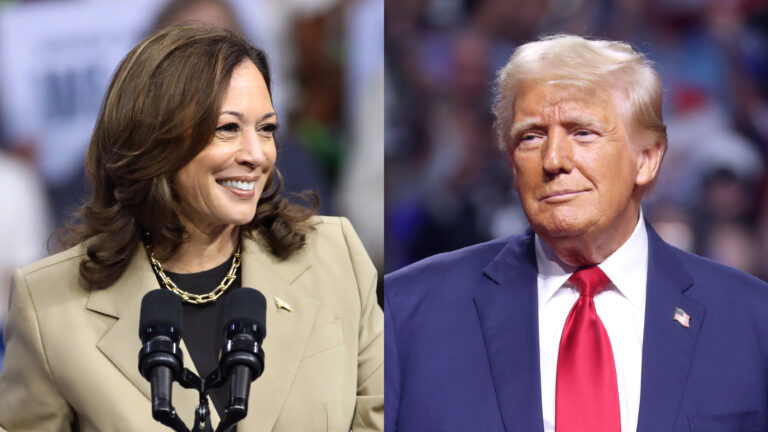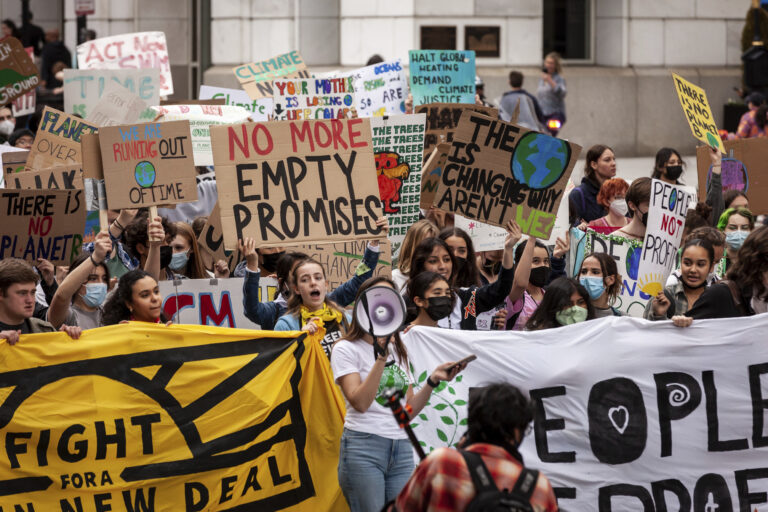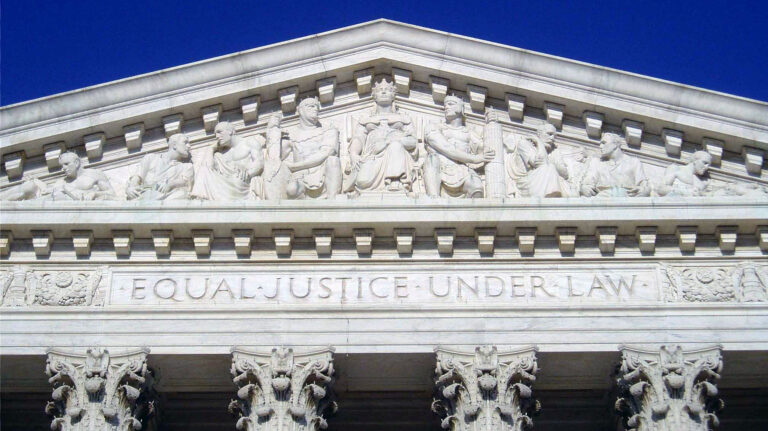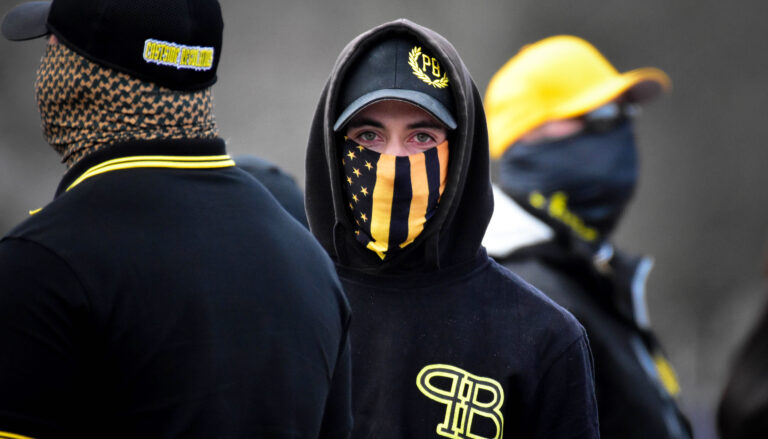A Close Presidential Election Could Turn ‘Messy’ — and Maybe Worse, Scholars Say
Berkeley political and legal experts say the Nov. 5 election will most likely be safe and secure, despite disinformation, mass confusion and threats of violence. But they see some scenarios that lead to crisis.

With the U.S. presidential election now just days away, worrisome signals are flaring on the political radar: Election officials in the battleground state of Pennsylvania sought to impede students from registering to vote. Ballot drop boxes were set ablaze in Washington, Oregon and Arizona. During an ominous rally at Madison Square Garden in New York, Republican presidential nominee Donald Trump bantered with Republican House Speaker Mike Johnson about an Election Day surprise.
“I think with our little secret we’re going to do really well with the House, right?” Trump said to his ally. “Our little secret is having a big impact. He and I have a little secret — we will tell you what it is when the race is over.”

In a campaign shaped by disinformation, threats of election interference and the potential for violence, Berkeley scholars say that such signals are further evidence that the 2024 election could be unpredictable and vulnerable to disruption. In a series of interviews, they agreed that the democratic process could face difficult tests in the days ahead.
“Given that Trump is the nominee, and given that he says the election was stolen from him in 2020, there’s every reason to believe that if he were to lose … he will contest it again,” said Berkeley political scientist Eric Schickler. “If the outcome is close, there’s good reason to believe there’ll be another significant effort to overturn it. There’s no guarantee that effort would fail. And even if it does fail, it’s sure to be a messy process.”

The threats to democracy generated by the campaign are so significant that the Human Rights Center (HRC) at Berkeley Law is mounting a major effort to track online election interference and violence, much as it did in 2020.
“What we’re seeing right now is disinformation and potential calls to violence from various politicians and members of the government towards their own citizenry,” said Alexa Koenig, faculty co-director of the center. “That immediately triggers various human rights concerns.”

A decade ago, few would have imagined such acute concerns about democracy and political rights in the U.S. But even as they acknowledged concerns, the scholars cautioned against overblown worry and fear.
“Generally, our elections are safe and votes are counted accurately and reliably,” said Emily Rong Zhang, an assistant law professor who specializes in election law. “There are numerous safeguards that govern the counting and processing of ballots. There is also, by and large, a lot of transparency in how our elections are run.”

While the democratic process might be tested, “the greatest likelihood is that our institutions will hold,” added Jacob Grumbach, leader of the new Democracy Policy Lab at the Goldman School of Public Policy. “I’d say that the risk of a true coup or electoral subversion is low — less than 1%.”
But another insurrection, maybe with violence, along the lines of Jan. 6, 2021? Grumbach doesn’t rule that out. And like all of the Berkeley scholars, he sees scenarios where the process could collapse, leaving the U.S. in a constitutional crisis, perhaps with leadership that was not brought to power by conventional means.
A close race creates incentives to challenge the rules
To understand the potential threats against democracy in this election, it’s essential to understand how close the vote could be.

Most experts agree that the outcome will be decided in seven battleground states: Arizona, Georgia, Michigan, Nevada, North Carolina, Pennsylvania and Wisconsin. In most of those states, recent polls show Trump and Democratic Vice President Kamala Harris in a very tight race.
A look back at 2020 offers an instructive — and startling — look at what may await next week.
Joe Biden won 81.3 million votes, about 7.1 million more than Trump. He needed 270 electoral votes, and by taking six of the seven battleground states, he won 306 to Trump’s 232.
But the electoral vote numbers are deceptive, and the margin was in fact impossibly close. With a swing of less than 77,000 votes, Trump could’ve picked up Arizona, Nevada, Wisconsin and Georgia — and the presidency.
With the race similarly close this year, the Berkeley experts said, there are strong incentives to compete fiercely, and perhaps not fairly, for every possible vote.
Vote suppression: Discourage youth voting in battleground states
Republicans have already shown a clear willingness to use tactics that are beyond the norms of democratic values and practices, often by marginalizing voters of color and young voters.
The Electoral College itself is often criticized for giving disproportionate power to conservative rural states. But Republicans have been more aggressive in using other “stack the deck” tactics: gerrymandering, vote suppression, and misinformation and disinformation.
Those tactics are in play this year, too, but often with a greater intensity than ever.

Joshua Clark, senior social scientist at the UC Berkeley Othering and Belonging Institute, said vote suppression remains a significant force. Often, he said, it’s targeted at young people — students, for example, who are attending universities away from their hometowns.
“There are restrictive voting laws that are going to impact especially what would be potential first-time voters,” Clark explained. For example, new laws were passed in some states that tighten voter ID laws, or limit access to ballot drop-boxes.
Such election changes can impact “people who don’t have a habituated practice of going to their polling location,” he said. “And that’s largely people who are new voters or young voters.”
Another example cited by Clark: In Wisconsin, students recently received anonymous text messages falsely warning that they could be prosecuted for improper voting.
Campaign strategy: “Everything changed after Jan. 6”
Four years ago, MAGA’s “Stop the Steal” movement led to widespread belief among Republicans that Biden had stolen the election, and it motivated hundreds of people who joined the violent attack on the Capitol in hopes of stopping the certification of the results.
Despite vast evidence that the election was honest and fair, those doubts have persisted.

Already, Trump is arguing that he cannot lose a fair election, and that he will never concede.
“Everything changed after Jan. 6, 2021,” said Schickler, the co-director of the Berkeley Institute of Governmental Studies. Perhaps the best way to understand 2024, he added, is as “the Post-January 6th Election.”
Grumbach agreed. “Mass voter fraud, the conspiracy of Stop the Steal — there’s no basis in reality for that,” he said. “Trump really ramped this up. … Now the Republicans are stoking concerns about mass voter fraud by undocumented immigrants as a way of increasing political support. This is having huge ramifications for trust in American elections, threats of political violence, threats of coups and so forth.
“It’s really gotten out of hand.”
Voter confusion may be the most powerful force in the land
To be sure, elected officials at the state and national levels have approved reforms to tighten the process and to prevent another Jan. 6. But the results have been mixed.
The Electoral Count Reform Act of 2022 did address some specific issues that allowed pro-Trump forces to interfere with the certification of the 2020 election, but Zhang and other Berkeley scholars say there are still loopholes.
What’s remarkable, they said, is the degree to which mass confusion is shaping the landscape for this election.
“There’s been so much effort since 2020 to push more and more mistrust and doubt in the voting system,” Clark said.
In focus-group research, he explained, “we hear people talk about doubts about their own preparedness to vote. They say they don’t follow politics closely. They don’t have all the knowledge. They’re overwhelmed by the amount of information that there is. They don’t know what’s reliable and what is not reliable. … It’s particularly with young people that we hear that kind of reasoning — and we’ve heard it over and over again.”
One swing state could throw a presidential election — one weak link in the 50-state chain. That’s incredibly dangerous.
Jacob Grumbach
“When people are confused,” Koenig said, “they don’t know who to trust or what to trust. … The seeding of disinformation creates tremendous vulnerabilities, where it seems like there are voids of reliable information. People are looking all over the place to see who and what they can trust. And as a result, they’re finding alternative narratives that are not coming from our large-scale institutions.”
Disinformation was epidemic in 2020, but it may be even worse this year, some of the scholars said. Russia, China, Iran and North Korea all have stepped up their effort to flood the U.S. communication ecosystem with disinformation engineered to deepen American divides. Billionaire Elon Musk’s purchase of Twitter has driven millions of users away from the site, but millions remain as it openly promotes disinformation and hard-right causes.
When a huge part of the electorate rejects the credibility of the mainstream news media and believes false claims about stolen elections or voting by undocumented immigrants, that clears a path for lawmakers and activists to attack and undermine democratic practices and institutions that constrain their power.
For example, Trump allies on the Georgia elections board had passed a series of measures ostensibly designed to reduce the risk of fraud, but the state Supreme Court stepped in to block those new rules.
Some states, Grumbach said, have made it easier to challenge election officials. Other states have approved measures to slow the ballot count. Zhang said she has been closely watching some state efforts to purge voters from their lists just before the election.
And in this climate of suspicion, threats of violence against election workers are surging.
“Systematically doubting the validity of elections and claiming that it’s fraud if you lose is just not consistent with democratic constitutional rule,” said Schickler.
Especially in a close election, even small successes by illiberal forces can change history, Grumbach added. “Thinking about electoral subversion, or a coup — one swing state could throw a presidential election — one weak link in the 50-state chain. That’s incredibly dangerous.”
Some scenarios for a democratic breakdown
Thus far, the system seems to be holding, but it may be shaky, Berkeley experts said.
Local election officials in jurisdictions nationwide have increased security at polling places in response to threats and episodes of intimidation.

Courts have blocked efforts to purge voting rolls shortly before the election — until this week, when Republican justices on the U.S. Supreme Court allowed Virginia to continue pre-election purging of suspected non-citizens. News reports say about 1,600 voters were targeted in the purge, some of whom appeared to be properly registered citizens.
While they expect the system and its guardrails to protect the integrity of this election, the Berkeley scholars acknowledged a complex set of scenarios in which the election — especially if the outcome is close — could be challenged, disrupted and thrown into chaos, and perhaps even be reversed.
If one of the candidates wins by a comfortable margin, Schickler said, that would reduce the likelihood of a protracted fight. For example, say Harris won by three states in the Electoral College, with a margin similar to Biden’s in 2020. Trump’s campaign might recognize that the outcome could not be reversed.
But suppose the count in the Electoral College was extremely close. Suppose that Harris won Georgia by 3,000 votes, a slender margin but just enough to get her to 270. A fierce challenge by Trump would be all but guaranteed. Georgia officials might find reason to declare the result illegitimate and refuse to accept her electors. The case would then go to the newly elected Congress for a decision, and it might be controlled by Republicans.
“I have no idea what would happen,” Schickler said. “There’s a pretty good chance that in that scenario it could get really bad. There are a lot of other scenarios where failure is less likely, but the fact that the system would fail in that scenario is a problem.”
In such circumstances, an extraordinarily complex fight could ensue across courts, state legislatures and Congress. The U.S. Supreme Court, dominated by conservative justices seemingly unafraid of political controversy, could be called on to help resolve the crisis, Zhang said.
Again, she said, if the election is close but not razor-close, the court might let the results stand, essentially as it did in 2020.
But if the result is very close, legal challenges that throw out a few thousand votes could change the outcome in a decisive state. Which could change the Electoral College vote, which in turn might mean that the Supreme Court, in ruling on those challenges, would in effect be deciding the winner.
“If the election will be decided by the Supreme Court, few, if any, of the guardrails we have will constrain its decision,” Zhang said. “That would be a very bad thing for our democracy and for the legitimacy of the court.”
Holding the line against violence and hate
There is another extreme scenario that could shape the contest and perhaps the outcome: violence, threatened or actual. And in the event of a contested election or a constitutional crisis, an event like Jan. 6 could inflame a mood of national crisis and dramatically increase pressure on election officials, lawmaking bodies and courts at every level.
Tracking evidence of possible violence, along with other major election interference, is the core objective of the Human Rights Center’s ambitious online monitoring project. More than 30 UC Berkeley students have volunteered to help intensively monitor mostly right-wing social media and chatrooms in the days before, during and after Nov. 5.
The HRC will report its findings in real time to its media partners in the project: the Center for Investigative Reporting; Mother Jones magazine; Reveal, an investigative radio show and podcast; and The War Horse, an online newsroom focused on military life.
Koenig said the center’s work is informed by patterns seen in the years when authoritarian parties came to power in Europe in the 1930s and ‘40s: In government and media, violence was cast as routine and authorized by prominent people, including government officials, while certain target groups were dehumanized. Similar patterns are evident now in the U.S., she said.
“I think we’re seeing that abundantly in online places with the weaponization of this idea against being ‘woke’ … and the norm of treating people with dignity and kindness and respect, is being broken down. These are all warning signals that we really need to be paying attention to.”
You’re reading over and over again, thousands of posts, saying, ‘Let’s kill this group,’ or ‘This group needs to be deported.’
Catherine Tong

Catherine Tong, a senior in comparative literature, is one of the student leaders of the project. The work requires extended exposure to cyber-bullying and other forms of toxic politics, they said.
The volunteers are “reading hateful speech online, with calls to really hurt specific populations,” Tong explained. “You’re reading over and over again, thousands of posts, saying, ‘Let’s kill this group,’ or ‘This group needs to be deported.’”
Many students on the project belong to groups targeted for online abuse, Tong said. They’re also affected by social shocks resulting from America’s rightward turn in recent years.
“I realized my life was going to be completely different on January 6th, as well as when Roe v. Wade fell (in 2022),” they said. “My life and the world as I knew it had changed forever. Now I’m extremely proud of the fact that we can do this work. We’re trying to monitor violence and figure out what’s going to happen before it happens. It’s really proactive.”
Even if we muddle through, will democracy continue to erode?
Despite all of these ominous scenarios, the scholars emphasize that there are many reasons to believe that crisis can be avoided.
In the chaos of 2020, in the midst of Stop the Steal and Jan. 6, important institutions were a bulwark. Leading Georgia Republicans did not bow to Trump’s demands to reverse the results there. Courts nationwide rejected specious claims of election fraud. Jan. 6 leaders and perpetrators were arrested and prosecuted.
“The most likely outcome is that we will muddle through,” Grumbach said.
Schickler largely dismissed the idea of an extended constitutional crisis in which the nation drifts for weeks without a president. “It’s almost certain a president will be inaugurated on January 20, 2025,” he said. “In that sense, it’s not going to be a stalemate.’

But he worried about another sort of stalemate, in which no matter who wins, half the country sees the outcome as unfair or unjust.
“The government would continue to operate, but it would be a constitutional crisis of legitimacy,” Schickler said. As a result, “a lot of bad things would happen downstream.”
In this sort of scenario, democracy doesn’t collapse suddenly, or by a lightning strike. Instead, a chance to stabilize and heal is lost. The slow erosion evident in recent decades continues, and perhaps accelerates, leaving the nation weaker still as the next presidential election approaches in 2028.
